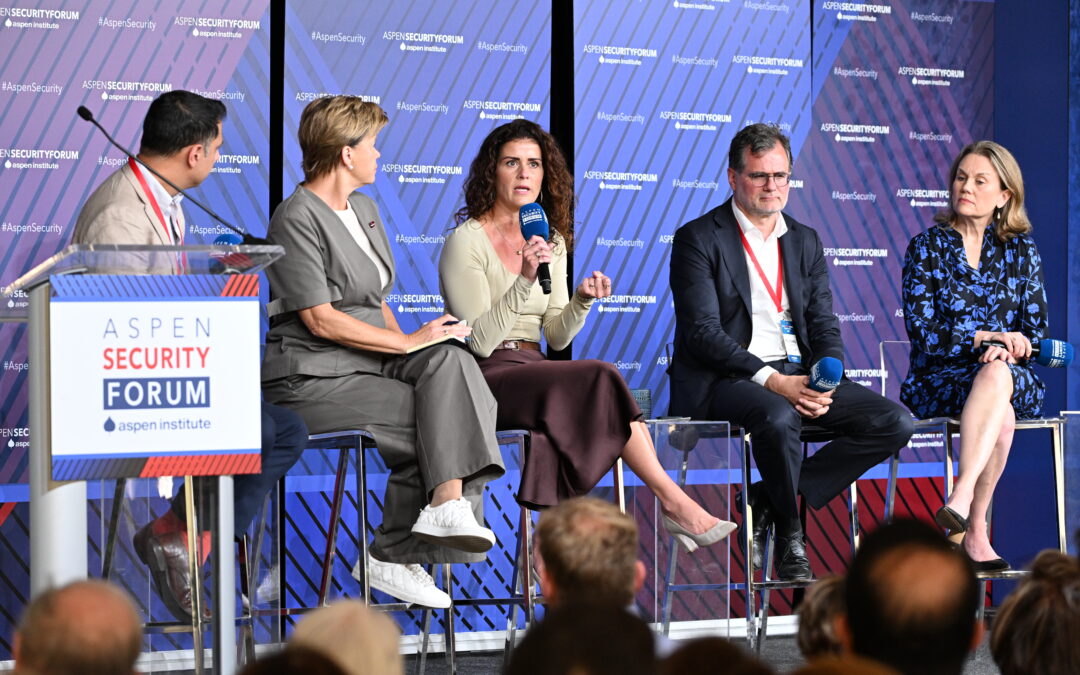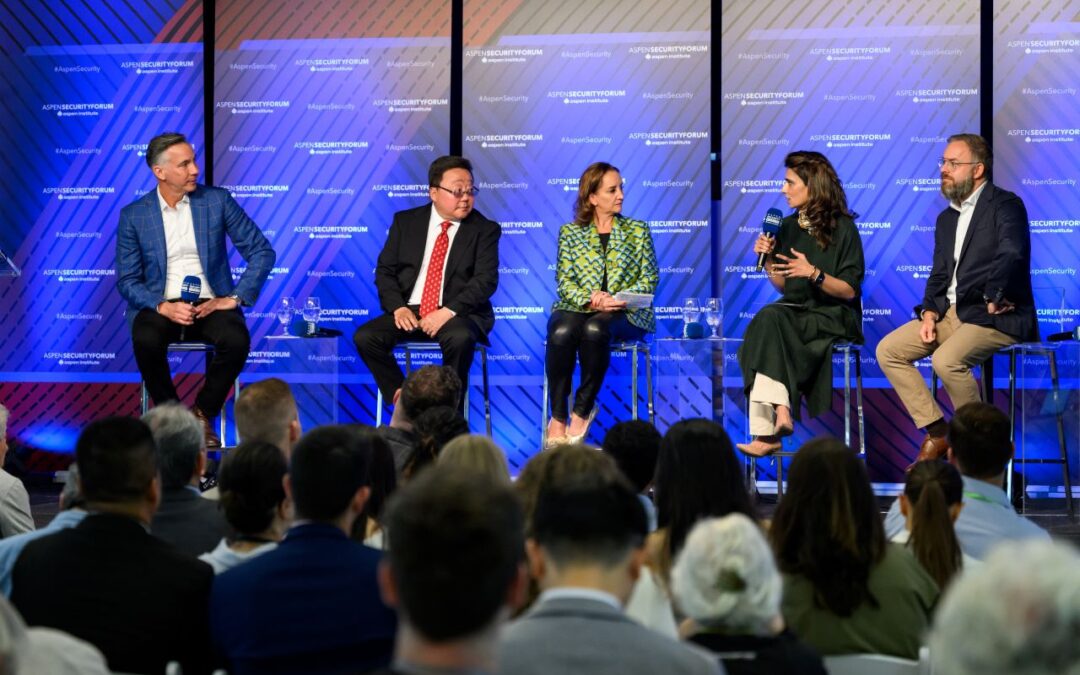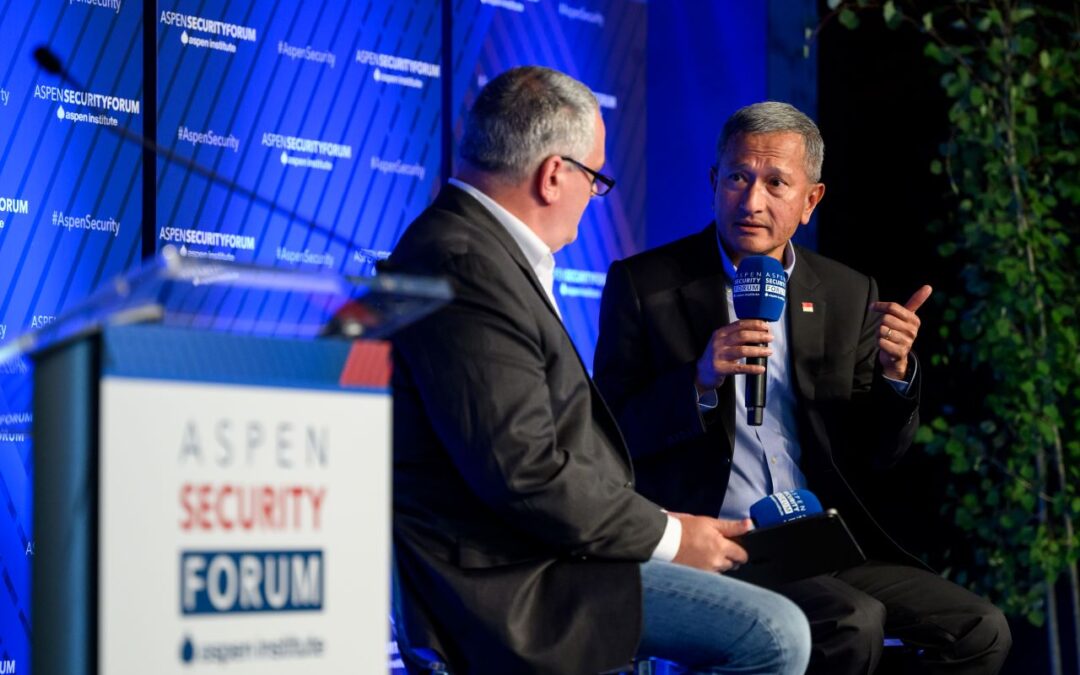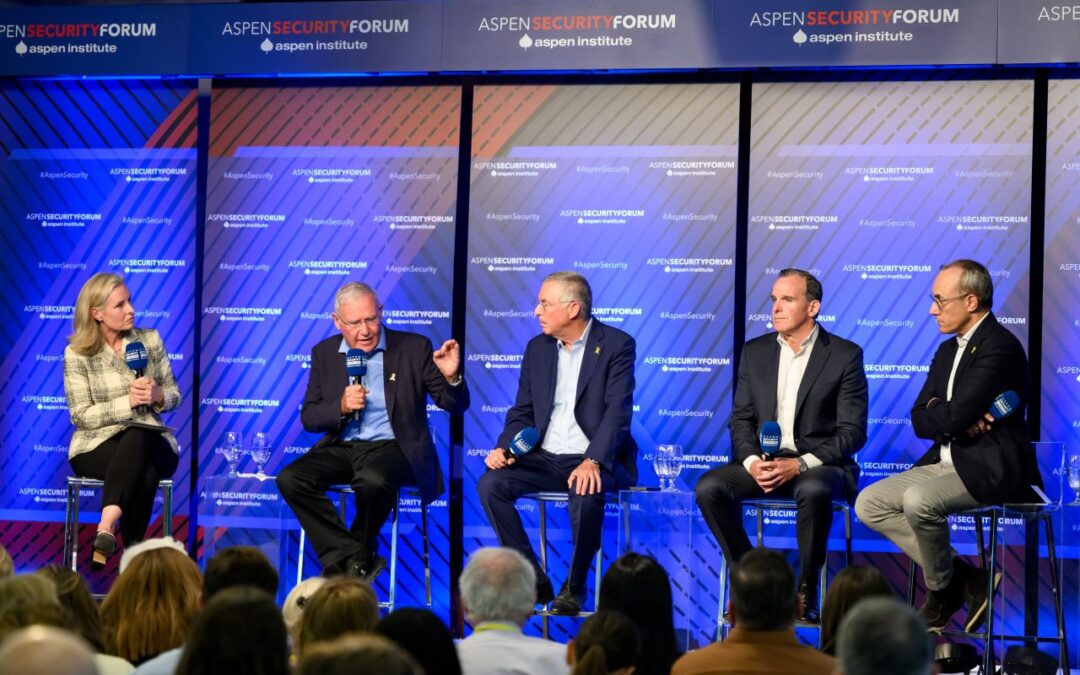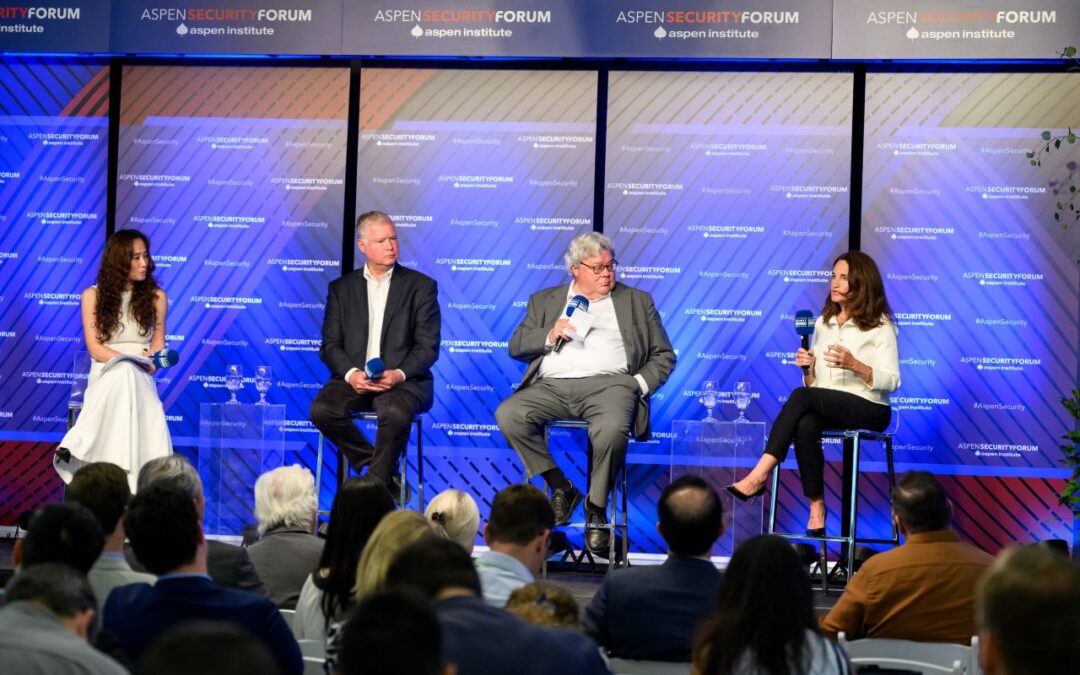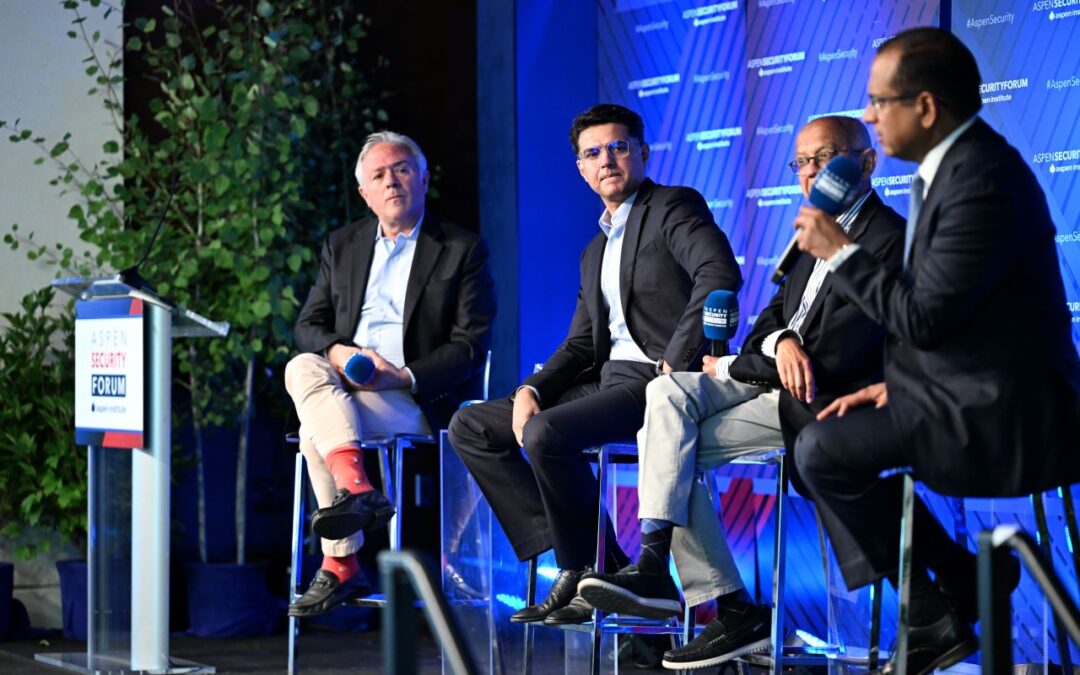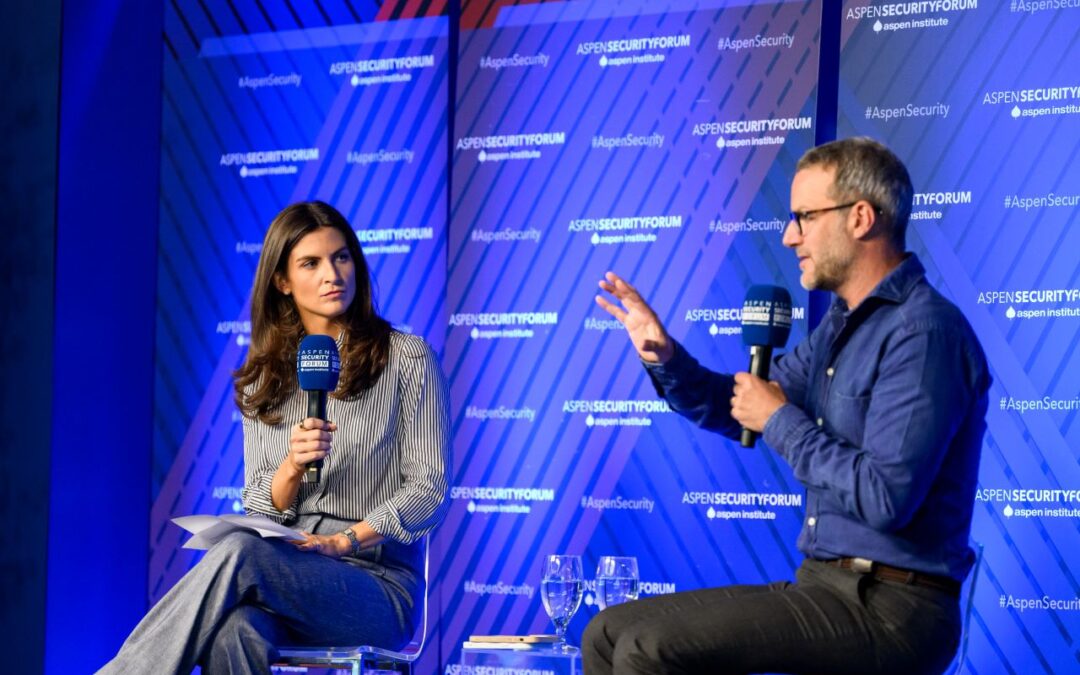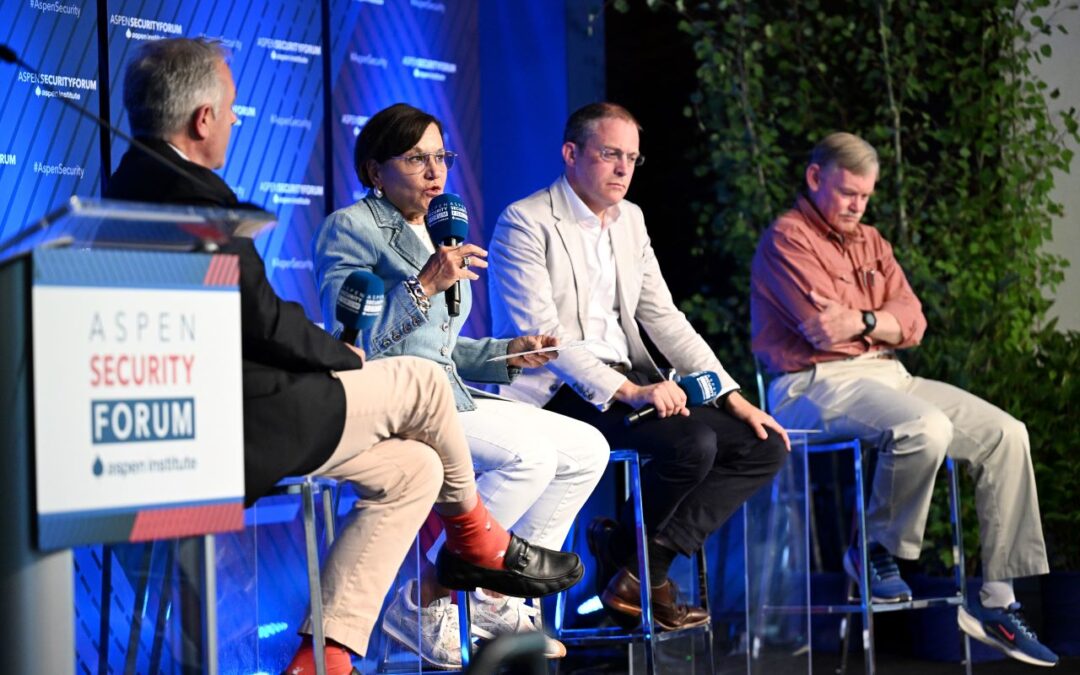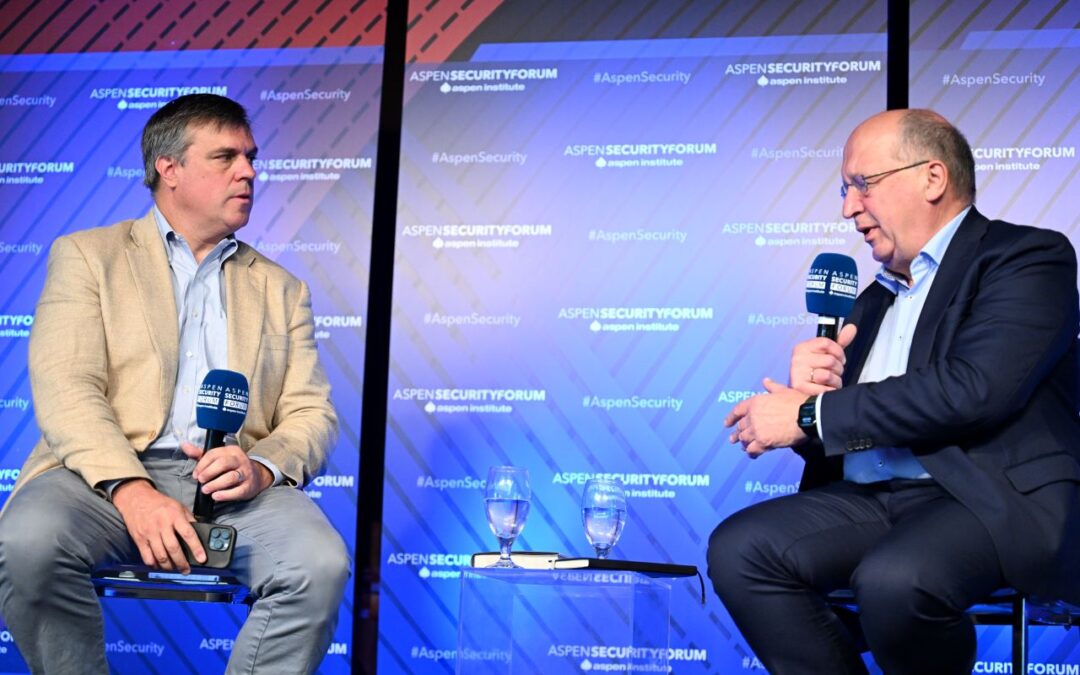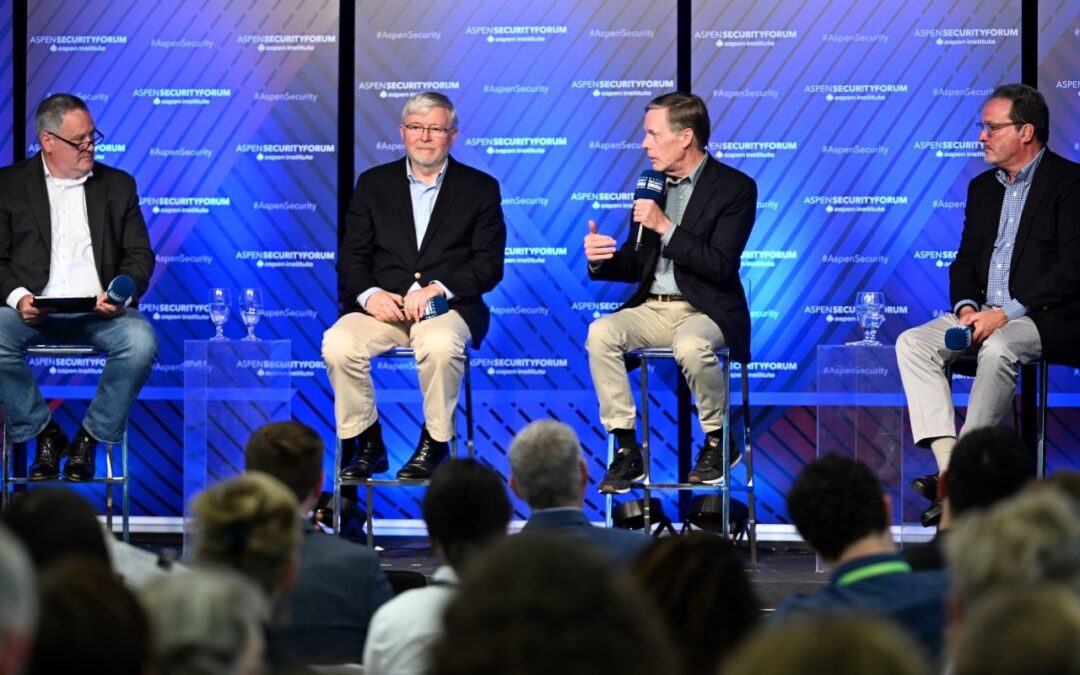Speakers
John W. “Jay” Raymond, Chief of Space Operations, United States Space Force
Moderator: Mary Louise Kelly, Co-Host, All Things Considered, NPR
Full Transcript
Read the full transcript below or download it to your device.
Click to read the full transcript
Mary Louise Kelly:
Please. Good afternoon.
General John W. “Jay” Raymond:
How are you?
Mary Louise Kelly:
I’m well. Good afternoon everybody. Can I join the happy dance that we are here? We’re together, we’re in person. Hallelujah.
General John W. “Jay” Raymond:
We’re not.
Mary Louise Kelly:
Yes. And can I also… I think general, we should kick off with thanks, with commending the organizers for starting the whole conference, the whole shebang with space.
General John W. “Jay” Raymond:
The coolest kids on the block.
Mary Louise Kelly:
There’s that. I also was reckoning that if you and I can sort the security challenges of the universe in the next 30 minutes, then the earthly matters that the rest of the sessions are going to be dealing with will be cinched, so here we are. A very basic question to start with, have you been to space?
General John W. “Jay” Raymond:
I have not. I think it’s actually worth delving into that a little bit, and understanding the distinction between the different sectors of space. And so when you think about it, there’s kind of three big sectors. The first one is a civil sector, I think NASA. And NASA is all about exploration and going to the moon and going to the Mars and scientific advisory, scientific discovery, and they are the ones that have astronauts that travel into space.
General John W. “Jay” Raymond:
There’s a commercial industry, and this is a really bad word to say in the space business. But there’s an explosion of commercial activity. And even though there’s an explosion going on, there’s… What used to be commercially viable was commercial launch, commercial Satcom. Now, because launch costs have gone down, satellites are more operationally relevant, smaller satellites, almost every mission area can have a commercial capability. And for the first time, we’re seeing commercial astronauts. And then there’s the national security side. And I think when I think of that, I think of the Intelligence Committee in DOD space. And that’s where I operate, and I operate firmly on the ground.
Mary Louise Kelly:
Well, and this is why I kicked off by asking if you were firmly on the ground or had been to space. I have not been either. I suspect almost no one in this room has, and it’s so striking because you come up in an institution, the military, that places a premium on experience. You’re not going to promote somebody to Admiral who’s never been on a ship, or air force general who’s never been on a plane.
General John W. “Jay” Raymond:
That’s right.
Mary Louise Kelly:
Was it hard when you assumed command to wrap your arms around, I am in charge of the military aspect of the space for the United States of America, and I’ve never seen it and I’m probably never going to.
General John W. “Jay” Raymond:
I might.
General John W. “Jay” Raymond:
So I guess, I grew up, as you said, as experience, I grew up in the air force for 35 and a half years. I’ve been a guardian in the space force for two years and six months, so coming up on 39 years of service. My whole career has been in the space business. Our whole career is meant to spent launching rockets and launching satellites into space, operating those satellites once they get into space, tracking those satellites so we can make sure the two things don’t collide. Largely since 1991, integrating space into everything that we do as a joint force. And so nothing we do, whether it’s humanitarian assistance or disaster relief, can be done as well without integration of space. Today, more so than in the past, we also have to worry about protecting and defending those satellites, and disposing of those at the end.
General John W. “Jay” Raymond:
And so that full spectrum is what our service does. We do it very, very well. I have had friends, I have friends that have gone to space, and it’s always nice to have somebody that’s been a satellite before that works on your staff. I actually have two NASA astronauts that are guardians. I brought them back from NASA. They’ve been helping us build a test program, but it’s not necessary to have been the space to be able to operate in space. We operate largely through two things, through communication links with satellites and through data. And that’s how we experience this through me.
Mary Louise Kelly:
So I want to get in just a minute to the… You mentioned, defending satellites. And I think there’s some interesting ground to cover there, but I want to give a little bit of background because there are probably people here who know all about space force and maybe people who watch Stephen Colbert’s take on it and then decided, I don’t need to worry about this again. You’re not laughing at that, I noticed. Did you watch Stephen Colbert? The little bit of background, you mentioned you’ve been in charge that… Space force was established December, 2019. So it’s not even three years old, still a baby.
General John W. “Jay” Raymond:
Terrible twos.
Mary Louise Kelly:
First new branch of the armed services in 73 years?
General John W. “Jay” Raymond:
Since 1947, 75 years.
Mary Louise Kelly:
Okay. And you’re organized under the air force, in a way not dissimilar from Marine Corps, in the Department of the Navy.
General John W. “Jay” Raymond:
We’re organized under the Department of the Air Force. There’s two independent services, and air force on our space, where just like the Department of the Navy.
Mary Louise Kelly:
Now, you were among those who were skeptical. I dug out note that you wrote 2017, and the headline was, we need to focus on space. We do not need a space core.
General John W. “Jay” Raymond:
That was the headline. I didn’t write the headline. I wrote the article.
Mary Louise Kelly:
But did you come round…? I mean, your views obviously evolved in some flash.
General John W. “Jay” Raymond:
There’s absolutely-
Mary Louise Kelly:
Yeah. Why?
General John W. “Jay” Raymond:
There’s absolutely no doubt in my mind, the quantifiable goodness we’ve had by establishing space force. And I’d say in fact, on a couple fronts. One, I think the air force is a better air force because they don’t have to worry about the space mission anymore. And two, you now have an independent service focusing on that domain. And the quality of people that we’re getting, the partnerships that we’re building with international partners with our commercial companies, increase and enhanced voice and requirements, and enhanced voice in the budget, enhanced voice as a member of the joint chiefs of staff in our concepts. And there’s no doubt that we are much better today than we were just two and a half years ago. And back then we were still the world’s best.
Mary Louise Kelly:
Part of the original thinking behind standing up space force was to deter conflict in space. So go there. What kind of conflict are we talking? What does it look like?
General John W. “Jay” Raymond:
Yeah. A lot of people talk about space deterrence, and the way I look at it is just it’s deterrence. And I think space provides a great opportunity, provides an opportunity to have one more fabric, if you will, of a means to change the deterrence calculus, impose cost deny benefit, and to deter conflict from beginning or extending into space, which we feel would deter conflict from spilling over onto the land. It’s deterrence. The way our department is talking about it now, in a kind of a cornerstone of our national defense strategy, is something called integrated deterrence, where we use the full weight of all domains, all of our partners, to be able to deter conflict. I mean, if we come to work every day wanting to deter great power war, I mean, that’s what we do. And then if that deterrence were to fail to win, but our primary goal-
Mary Louise Kelly:
What does that actually mean? I mean, how do you deter conflict?
General John W. “Jay” Raymond:
Well, the way we could add to that deterrence is for example, to protect and defend our capabilities. I think it’s clear, if deterrence were to fail and we were to get into a conflict, maybe the first place where that conflict might start is in space. If we can protect our capabilities, we can assure our access and freedom to maneuver in the domain, because they are both vitally important.
General John W. “Jay” Raymond:
There’s not a single person in this room that doesn’t use space each and every day. Most of you use space multiple times before you’ve had your first cup of coffee. There’s no other service, military service, that has a closer connection with the people on the ground than the space force. You use GPS every day, weather satellites every day, communication satellites every day. And our goal is to make sure that those are always there. When you go into the room and you turn on light switch, lights are always on. We want space to always be on.
Mary Louise Kelly:
And that’s so interesting that you can see a war breaking out that would start in space and then find its way down here. What does that mean? That’s somebody trying to take out a U.S. satellite, blind the U.S. military, is that the type thing?
General John W. “Jay” Raymond:
They could. Our job is to make sure that doesn’t happen. And so one of the things that we’re thinking through is designing our architecture to be more resilient by design. We are the world’s best in space. We have the most exquisite capabilities. We have the greatest commercial industry. We’ve got the greatest partners, but those capabilities were really built for a different domain. The domain has changed significantly over the last couple decades. Significantly. I can get into that further if you’d like as well. And we need to shift, and so one of the things that we’re doing is looking to… Just like you do with your financial portfolios, you diversify your financial portfolios. So you’re not beholden on one stock if it were to go bad for your wealth. We want to diversify our portfolio to make it more resilient by the design of the architecture.
Mary Louise Kelly:
We’ll get into that, why the domain has changed so much in the last couple decades. Is that because America’s adversaries are getting more aggressive out there?
General John W. “Jay” Raymond:
I think it’s the way we talk about how the domain has changed. We talk about kind of three things. First, it is more congested. If I was here a couple years ago, I would’ve told you that our space force guardians and the capabilities that they operate, that we were tracking about 22,000 objects. Today that number’s 50,000, close to 50,000. I would’ve told you a couple years ago that of those 22,000 objects, about 1,500 were satellites. Today, that number is closer to 5,000 satellites. In fact, Elon Musk SpaceX company operates over 2000 satellites on its own. So it’s more congested. I think the reason why it’s more congested, it used to be… Space was great power competition between us and the Soviet Union. Now you have students launching satellites, and that’s because launch costs have gone down largely because of commercial launch. And smaller satellites or more operationally relevant.
General John W. “Jay” Raymond:
And so there’s more objects up there. It is much more competitive. I talked about the explosion of commercial space activity, there’s competition going on in the domain, just like it is on the ground. And it is much more contested. And on the contested nature of the domain, everything from reversible jamming of communication satellites and GPS satellites, as an example, to kinetic destruction when China blew up one of their own satellites in 2007, and Russia did that just here recently. And so there’s a full spectrum of threats that we’re worried about, to make sure that, again, that we can provide those capabilities to each and every one of you.
Mary Louise Kelly:
You talked about how it used to be the U.S. MUSSR, the great power competition, but up there. How aggressive is Russia today in space? We see them on earth. What about up there?
General John W. “Jay” Raymond:
Just as the strategic environment on the ground is changing, very similar to some of the open comments that were made, that’s happening in space as well. So we saw last November where Russia did a very destructive act, what I would say is irresponsible act, and blew up one of their own satellites, and blew it into over 1500 pieces of trackable debris that we’re tracking. And then we act as the space traffic control for the world. And we make sure that people don’t hit that debris and other things in space. Back when it was the Soviet Union and the U.S., building a space program, there was… There’s always been military activity in space. I mean, that was the root of that great power competition.
General John W. “Jay” Raymond:
What changed largely was in 1991 in desert storm. And what was, nuclear command and control and strategic missile warning satellites to make sure we could tell what the then Soviet Union was doing. People refer to desert storm as the first space war, and it’s… I really believed the cold war was actually the first space war, but it’s clearly the first war where we took space capabilities and integrated those space capabilities into a theater of conflict. And so if for those that are old enough to remember, the U.S. forces did a left hook through the desert. Well, how do you do that at night in a desert featureless train without street signs telling you where to go. You do that using a, at the time, a fledgling GPS capability. If you recall, there were Scud missiles being launched.
General John W. “Jay” Raymond:
How do we detect those? Well, we use strategic missile warning satellites, innovatively to figure out kind of in a very rudimentary way, which way they’re going and provide some basic warning. Precision, the first use of precision. Today, there is nothing we do as a joint force, nothing that is enabled by space. And so just as you use space each and every day, our joint force uses space each and every day for everything we do. And it is a huge force multiplier.
Mary Louise Kelly:
What about China? I have heard you point to China and its leap to near parody with the U.S., your words, how near?
General John W. “Jay” Raymond:
China has gone from zero to 60 very quickly. and they are clearly our pacing challenge because they have… Again, they’re moving at speed. They have the economy to support the development. They’re really doing two things. The first thing that they’re doing is they’re building space capabilities for their own use. So just like we’ve enjoyed space capabilities that we’ve been able to integrate, China has built a space program to do the same thing. That provides them advantage, and that provides risk to our forces. The other thing that they’re doing, they have seen the advantages that space has provided us as we’ve integrated space, and cyber and multi-domain operations. And to be honest, they don’t like what they see. And so in that spectrum of threats, they’re also developing capabilities, like demonstrated in 2007, where they blew up a satellite into 3000 pieces of debris, a little over 3000 pieces of debris. Of that 3000 pieces of debris, almost all of it it’s still up there.
General John W. “Jay” Raymond:
In fact, we warn China that they’re about to hit a piece of debris that they burst. We are really working hard to kind of the rules based order if you will, in space. And today, one of the challenges is there are no rules, or very few rules. It’s the Wild Wild West. And so, one of the things that the U.S. is really leading with our allies and partners, is trying to develop norms of behavior for what’s safe and professional. It is totally irresponsible and unprofessional to blow up a satellite, litter the domain and threaten the use of that domain for world economy, for… I mean, space under pins every instrument of our national power.
Mary Louise Kelly:
You talked about how war could start in space and then would then show up down here. Do you see it going the other way? Like right now with tensions with Russia and sanctions, conflict in Ukraine, or when trade war heats up with China, do you see them acting more aggressively in your-
General John W. “Jay” Raymond:
I think, again, just like I talked about on the deterrent side, I would say on the conflict side or war side, it’s just war. And some nations might choose to fight war on the air, in the land and the sea, now in space. And so I don’t think there’s a set game plan that says they’re going to start here and do this and do this, but it’s clearly a domain that could provide them advantage as well.
Mary Louise Kelly:
What about U.S. allies? I saw Australia just showed up, stood up its answer to space force just this year.
General John W. “Jay” Raymond:
Right. Yeah. It’s been pretty remarkable. As I mentioned upfront, one of the things that I think has been the biggest advantage of establishing the space force, is that our close partners are following suit. And so Australia just stood up in Australian space command, which is their version of a space force. Italy, I’m sorry, Spain just renamed their air in space force. France stood up a space command about three… Just a few days after we stood up ours back in 2019. The UK has elevated space in their countries. Japan has elevated space in their country. So it’s become really clear for the nations around the world, that this is a very important domain for all of us, and that it required some elevation to the level of importance that it is for their nations.
Mary Louise Kelly:
So as we watch war in Ukraine play out, the U.S. is obviously not at war in Ukraine, but we are providing military and intel capabilities. Does space force have a piece of that?
General John W. “Jay” Raymond:
As I mentioned, there’s nothing that goes on in for any nation around the world that would… For anything that a military would do in any nation around the world, they’re going to use space. A lot of people ask me, what are the lessons learned that’s come out of Ukraine? That’s too soon for that. I mean, there’s not. I wouldn’t sit up here and say, here’s the lessons, but there’s a couple observations that I have. First, the observation I’d say is that space is important. And we have seen that in this conflict. I would also say that commercial space has been very important and they have provided some… Commercial spaces provided capabilities that have been helpful to Ukraine as well. And so those are a couple observations. One was reaffirmed, and two is kind of emerging as commercial space continues to grow.
Mary Louise Kelly:
Can you speak to the intelligence piece of this? You just became the 18th member of the U.S. Intelligence Committee, the 18th U.S. fire agency. Congratulations. What is that actually? What does space force intelligence do?
General John W. “Jay” Raymond:
I think there’s… When I think about space intelligence, I put it into two bins. The first is intelligence from space. That’s largely a mission area that is not part of our service. That’s part of Intelligence Committee. One of the things that we’re exploring-
Mary Louise Kelly:
NRO, National Reconnaissance Office?
General John W. “Jay” Raymond:
Right. And we’ve got a spectacular partnership with the NRO. It’s never been better. I think there’s about… We share people. We share operation centers, we share concepts, we’re building programs together. The partnership has never been better. And I mean that in all sincerity. And we’re also looking at what… In that ISR business, which is traditionally the Intelligence Committee business. We’re beginning to think through what ISR mission should be in the space force as well, that conversations are beginning.
General John W. “Jay” Raymond:
The other thing that I look-
Mary Louise Kelly:
Can you share any early seeds, early threads on that? I’m just curious why space force needs to have its own intelligence arm when you have the NRO, when you have NSA.
General John W. “Jay” Raymond:
Yeah. So every one of the services is a member of the Intelligence Committee. So we provide information and we provide requirements into that, so that’s normal. That’s what all services do. The other piece of it though, is we also need intelligence for space. We need to understand what’s going on in the domain. What we call intelligence, historically for space has been space situational awareness. And traditionally, because there was not a threat in the domain, it was all about where something is in space. You’re a satellite. I want to know exactly where you are. So I make sure I don’t hit you, that two things don’t collide. That’s not good enough today in a domain that’s contested. You have to know a lot more than that.
General John W. “Jay” Raymond:
And so, as we establish a space force, just like all the other services, we have intelligence professionals on our team, that’s another area that we’ve really made some great strides on. And we’ve embedded those in terms professionals with our operators to make sure that we have a better understanding of the domain. We have a better understanding of the strategic environment. And I think it’s been helpful to us.
Mary Louise Kelly:
Yeah. I’m going to open it to questions in just a minute, and I’m sorry, but I’m going to restrict the questions to the rising leaders program. The young leaders who Onya mentioned, who are here, and I know that they have a few questions, which you’ve graciously agreed to take, but just before… Again, I’m going to grant myself one more question, which is the rules of the road question, which feels so relevant.
Mary Louise Kelly:
Now that you’re telling me, how many things you’re having to track? How busy a traffic zone it is. The vice president, Kamala Harris, just recently announced the U.S. is not going to engage in destroying any satellites up there. She said, “We’ll lead the way. And I encourage everybody to follow us.” Are we sensing? Are Russia and China, other people on board with this?
General John W. “Jay” Raymond:
And I was there with the vice president and appreciated her leadership on this. And this is something that the U.S.is leading on. This is something that we’re trying to establish the norms, if you will, the rules of the road. What Vice President Harris announced was that the U.S. commits not to conduct destructive, direct ascent, antisatellite dusting, very similar to what China and Russia have done that I’ve talked about. We think it’s irresponsible to litter the domain with debris.
General John W. “Jay” Raymond:
We are working very closely with our partners and being very transparent in how we operate in the domain. One of the things that we want to do is we want to demonstrate good behavior. And so we’ve worked with our close partners and said, “Hey, here’s how we think we should operate.” The secretary of defense is written a memo, signed a memo that says here’s kind of five principles that we’re going to live with. One of those principles is we will not create long lasting debris as an example. So there’s also discussions going on in the United Nations amongst nations to figure out what are those rules of the road. I really believe we need to get those in place for all three reasons, increase congestion, increase competition, and increase contested nature of the domain.
Mary Louise Kelly:
It feels a little bit like the rules of war for cyber warfare. To a certain extent you’re making it up as you go because it’s so new.
General John W. “Jay” Raymond:
That’s exactly right. It’s not a new domain, but the domain has changed. And so, what are rules of engagement? What’s hostile intent? All the things that… We have had years and years and years to think about in other domains, this is a new domain in that sense. And we’ve got a lot of working with our allies and partners to figure that out and the U.S. is leading the way.
Mary Louise Kelly:
All right. Young leaders, you’re on. Where are you?
Geo Saba:
Ma’am.
Mary Louise Kelly:
Yes, sir. Do we have to hold on one second? We’re going to get a mic all the way down this road to you. If you want to introduce yourself, that’d be great. And we’d loved your question.
Mary Louise Kelly:
Hi.
Geo Saba:
Great. Thank you. Hi, my name is Geo Saba. I’m the chief of staff for Congressman Rohit Khanna who represents Silicon Valley.
General John W. “Jay” Raymond:
Yes. Absolutely.
Geo Saba:
Sits on the Armed Services Committee. I’m curious how you think about the talent pipeline and recruiting best and brightest minds to join the space force.
General John W. “Jay” Raymond:
I’ll tell you. We are having great success at that. It’s a little different challenge. We recruit about 500 enlisted guardians a year and about an equal number of officers. On the enlisted guardian side, 500… So the way we started was we put folks out in recruiting stations and if somebody came in and said they want to go into the space business, we’d recruit them. And so we really would get the first 500. We started thinking about it and said, that’s probably, we can be a little bit more selective than that. So we can get 500. So what we’ve done is we use those recruiters to develop the pool of people and then we give them other assessments. And then we actually have a board and we hand pick everybody that comes in.
General John W. “Jay” Raymond:
Same thing on the officer side, we hand pick everybody that’s coming in. We have more people knocking on our door, wanting to come into our service that we can take. And so it’s a good problem to have. Not only do we have more, we have incredible talent. I mean, the talent level that we’re getting on both the officer and the enlisted side is significantly… Not that I was bad, but they’re a lot brighter than I was. And it’s road scholars, cadet wing commanders, pro football players. I mean, we’ve got NCAA steeplechase champions. I mean, the talent that we’re getting across the board is pretty remarkable. And the thing that’s really cool, they’re very interested in the digital age. So we’re building this service as a service for this digital age that we live in. We’re increasing the digital fluency. We’re building our own software coders. We’re being innovative and that’s exciting our nation’s youth.
Mary Louise Kelly:
I think that was a recruitment pitch we just heard. It’s not too late if you’re in. I see a question over here.
Daniel Lippman:
Hello, I’m Daniel Lippman. I cover the white house in Washington for Politico. Thank you for joining us. I was wondering, would your military job be easier if space was more regulated and nations agreed to rules of the road?
General John W. “Jay” Raymond:
I firmly believe that we need to develop in order of behavior rules of the road. The U.S. and this and our partners are working on that. That would be one of my goals, to check off that there’s a set of rules that all can follow, like there are in other domains.
Mary Louise Kelly:
How would that be enforced?
General John W. “Jay” Raymond:
Well, I’m not naive to think that it’d be hard to enforce, but if we had a set of rules and you run through the red light, we can say you ran through the red light. And so it help identify bad behavior.
Mary Louise Kelly:
All right. That’s fine. Next. Let’s see. I see two right here. So we’ll go to you, sir, and then behind you next.
Speaker 5:
I’m not sure I can speak loudly. I just need to know-
Mary Louise Kelly:
Hold on. We’re almost with you. Hold on. I just want to make sure everybody can hear you.
Speaker 6:
[inaudible 00:27:19].
Mary Louise Kelly:
Nice.
Speaker 5:
Okay.
General John W. “Jay” Raymond:
Hi.
Speaker 5:
Can you discuss lasers from space?
General John W. “Jay” Raymond:
All I would say is that in that spectrum of conflict or threats, everything from reversible jamming to kinetic destruction, there would be directed energy threats that we’d be concerned about as well.
Mary Louise Kelly:
Yes, sir.
Stephen Shapiro:
Thank you very much. Stephen Shapiro from Ben’s and the Atlantic Council. And first, just a quick note, Mary Louise, I’m a New Yorker. It is a delight to see you in person.
Mary Louise Kelly:
Thank you. And you.
Stephen Shapiro:
Thank you. Sir, NATO is admittedly a newbie with respect to space. Can you comment on its struggles with respect there too, considering the membership issues as well as how the United States can assist in that regard, so as to get there.
General John W. “Jay” Raymond:
Yeah. So NATO back in 2019, I think it was… Don’t quote me on this. I think it was October, 2019.
Stephen Shapiro:
[inaudible 00:28:35].
General John W. “Jay” Raymond:
Not October, November. I think it was October. Don’t quote me on the date. You can quote me on what I’m about to say. Named space operational domain. Shortly thereafter, they also stood up a space command and control center in Germany, and shortly thereafter, they’ve named or establishing a center of excellence into Los France. And so they’ve made some pretty significant strides here, just over the last couple years. It’s a partnership that we enjoy. It’s a partnership that we support. We have people that we assign, for example, to that C2 cell. We’ve got great relationships with our NATO partners. In fact, I was just over in Europe this past week and was at air chiefs and space chiefs conference with 60 something air and space chiefs from around the world. And so again, we’re working very closely with NATO. And if you think about what’s in NATO’s DNA as deterrence, that partnership we think is going to be very valuable for us.
Stephen Shapiro:
Just quickly. Do you think they’re where they ought to be?
General John W. “Jay” Raymond:
I would say this is a relatively new domain and we all have growth, but they’ve made some great strides.
Mary Louise Kelly:
All right. We’re going to see if we can take one more.
Mary Louise Kelly:
Yes. The gentleman right here.
Ralph White:
Hi general, Ralph White from defense career to Corporation University.
General John W. “Jay” Raymond:
How are you?
Ralph White:
Excellent, sir. I did 35 years as well.
General John W. “Jay” Raymond:
Thank you.
Ralph White:
Just one question.
General John W. “Jay” Raymond:
We can get a ICAT few more years out of you.
Ralph White:
Junk in space.
Mary Louise Kelly:
I told you it’s a recruitment pitch. He’s all right.
Ralph White:
You talk about junking space. I enjoyed your presentation. It was very frightening for me obviously, but junk in space, what are we going to do if we can’t get with these other countries and you know how hard that is? That’s all.
General John W. “Jay” Raymond:
So people ask me a lot about the congested nature of the domain and the amount of debris that’s in space. And they always ask, how do you solve that? I think the first thing you do, you solve it by not creating it in the first place. And so that’s really what we’re working on initially. And so things like acting is the space traffic control for the roads. So two objects don’t collide, warning folks that they need to move again towards that end, having better engineering standards. So when satellites reach the end of the life, they don’t break apart into pieces.
General John W. “Jay” Raymond:
Having better engineering standards for a launch vehicle. So when they launch, we don’t litter the domain with debris. And so that’s primarily the first step. That’s really what we’re working on in the space force. And we’ve got… Then we’re thinking through how you might then also remove some debris that’s in the domain. The challenge is, the space domain is very vast. There’s a lot of stuff up there. I talked about the number of objects that we can track. There’s a lot of objects that are too small to track. And if you are allowed-
Mary Louise Kelly:
Which is too small to track?
General John W. “Jay” Raymond:
Well, let’s just say kind of a softball size, is both that-
Mary Louise Kelly:
You got basketballs, you’re good.
General John W. “Jay” Raymond:
Basketballs we’re good. But if you’re the size of a paint fleck, and you’re going 17,500 miles an hour, because that’s how fast you have to go to stay in space, and it hits you, it’s going to hurt. There’s a lot of stuff up there. It’s a very vast domain and things are moving very fast. And so I think primarily, we need to make sure that we have… Again, going back to the norms and behavior and to make sure that we do things smartly, so we don’t create the debris in the first place.
Ralph White:
Thanks.
Mary Louise Kelly:
General Raymond, thank you.
General John W. “Jay” Raymond:
Thank you.
Mary Louise Kelly:
Thank you. [inaudible 00:32:37].
General John W. “Jay” Raymond:
For being a part of this.
Speaker 9:
That’s great.
General John W. “Jay” Raymond:
Thank you.
Speaker 9:
Excellent.
Mary Louise Kelly:
Thank you for keeping us off.
Speaker 9:
All right. Thank you very much, General Raymond.



